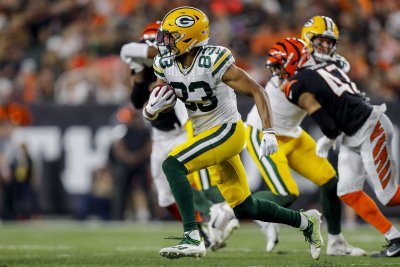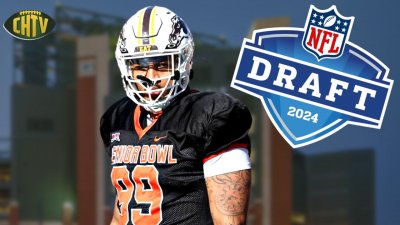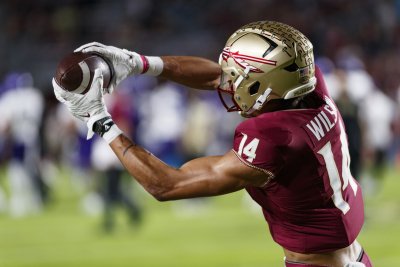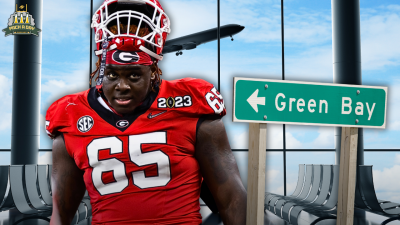Setting Up Play-Action With the Run is False
Setting up the play-action pass with the run is one of the ideas that pervades the NFL, but is it true?
By hobbes

One of the principle ideologies that the Packers have followed is that running the ball opens up the passing game. In the years between Ryan Grant and Eddie Lacy, the Packers would run the ball even when it was completely ineffective to give the offense a semblance of balance. Mike McCarthy would often preach that a high volume of running plays (even when they put the offense behind on down and distance) was still advantageous since it kept defenses guessing and would make the play-action pass even more dangerous.
In 2015, the Packers were literally the worst play-action passing team in the league, ranking dead last according to Football Outsiders. To compound matters, the Packers were actually pretty respectable at passing the ball normally, ranking 9th in the league. Given that the Packers ranked 2nd in play-action plays in 2014, my initial hypothesis was that it was the decline of Eddie Lacy that resulted in poor play-action, after all if conventional wisdom is correct, an ineffective Lacy would result in defenses playing for the pass, which diminishes the play-action passing game.
To test this, I compiled the play-action pass DVOA and running DVOA from Football Outsiders for the last three years and ran a correlation analysis to see if effective running games would lead to more effective play action passes.

As you can see, the data points are all over the place, indicating there really isn’t any correlation between rushing efficiency and play-action efficiency. Indeed, the correlation is p = .1477 (not significant), meaning a better running attack doesn’t result in better play-action passing.
The obvious conclusion is that even with a great running back, you still need a quarterback who can execute an effective play-action passes and some teams with fantastic quarterbacks just don’t run play-action all that much; Philip Rivers and Peyton Manning are more true pocket passers who lack the speed/agility to really execute a roll out play-action pass.
In conclusion, it would be unreasonable to solely blame Eddie Lacy (and to some extent James Starks) for the precipitous drop in play-action efficiency. If anything, wide receivers dropping balls, the lack of a solid seam breaking receiver and uncharacteristic inaccuracy from Aaron Rodgers are probably just as much to blame for the Packers play-action woes in 2015.













Comments (11)
Mark Lindwall
July 15, 2016 at 02:14 pm
Insightful analysis. Thank you. Let's hope ARod gets it back together this season.
Bearmeat
July 15, 2016 at 02:57 pm
Awesome stuff once again Thomas. You bring some serious knowledge to our little corner of the interwebs. Thank you.
LeagueObsrvr
July 15, 2016 at 03:58 pm
<em>If anything, wide receivers dropping balls, the lack of a solid seam breaking receiver and uncharacteristic inaccuracy from Aaron Rodgers are probably just as much to blame for the Packers play-action woes in 2015. </em>
Very good article Mr. Hobbes. Hopefully they get these issues fixed this season.
Bohj
July 15, 2016 at 04:58 pm
I'm not sure how the data correlates directly. Most Packer fans would agree that we were not an effective running attack last year. The Oline was dinged up, Lacy was not Lacy, and Starks found silicone lube on his gloves. We couldn't run enough to get a rythym or respect from opposing Ds. When they can stop your run with their front 4, 5, 6, or 7 guys you never have to commit a safety to the box. Even though our pass attack was OK overall....it's not because of play action. We still had completions into double coverage, and open zones underneath, but I doubt that says much about the running impact. Running the ball is crucial to take teams out of cover two and high safety looks. We didn't do that. Data is less important to me than having guys single versus double covered. That's the real purpose of effective rushing. When you don't have to commit a safety to the run or to Jordy......the offense becomes more limited. Period.
hobbes
July 15, 2016 at 05:19 pm
The answer is that the data does not correlate, meaning how good a team is at play-action pass has nothing to do with a strong running game.
The statement "running the ball causes defenses to get out of cover 2" is beyond the scope of this analysis, which is really only looking at play-action passes and not what the defenses specifically are doing. It would be interesting to see if there is a correlation, but I'm not sure the data exists; I certainly have not seen any defensive data split by formation (which is kinda hard given defenses are often fluid pre-snap while offenses are more rigid).
Doug_In_Sandpoint
July 15, 2016 at 05:56 pm
Way too much analysis for me. Need to dumb it down.
What I really want to hear about is The Bachelor, or Big Bachelorette or whatever...
I heard that Travis Jervey's 2nd cousin was on Naked and Afraid and was seen hanging out with Nicole Richie.
MarkinMadison
July 15, 2016 at 10:17 pm
Interesting read but I'm not sure I buy the argument. Correlating DVOA for PAP and Run for each game seems to assume that defenses adjust instantaneously. Defenses don't work that way. Defenses come into a game with a game plan. They may make some adjustments along the way, but they don't instantaneously change the plan. This is particularly true when you got a QB like #12 in the backfield. They will dare you to run and take their chances most of the time. Last year was the exception. No deep threat led to stacking the box. I'm just not convinced that these metrics are reflective of reality enough to explain what is occurring on the field.
hobbes
July 16, 2016 at 10:00 am
Actually the DVOA data I used it for all 32 teams from the last three years so it's a much broader picture than just game by game or play by play.
MarkinMadison
July 16, 2016 at 01:27 pm
So what is each single data point on the graph then? Is it not run v. PA for a single game?
NashvilleCheesehead
July 16, 2016 at 06:48 am
We have to be careful not to confuse correlation with causation. The sale of ice cream is correlated with weight loss. When the weather is nice, people go outside and move around get exercise, and spend a lot less time feeding their pie holes in front of the television. It just so happens that this is also the kind of weather that causes people to buy more ice cream. So those two things are correlated, but one does not cause the other.
By suspicion is that all of the factors cited by the commenters are what are really at work here. It is hard to run an effective offense with a banged up offense of line, injured wide receivers, and overweight running backs. Those are probably the causal variables, not play selection.
hobbes
July 16, 2016 at 10:01 am
I agree but when I'm arguing that there's no correlation, it should be much easier to conclude there's no causation either.